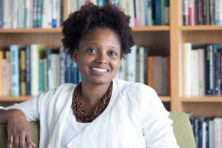Poetry Lessons: A dinner and reading with United States Poet Laureate Tracy K. Smith
- Share
- Tweet
- Pin
- Share
Earlier this year, after the big April snowstorm and when the snow was beginning to melt, I came across a dead coyote atop a rock wall next to the highway. The image was striking, powerful, unsettling. I saw it for only a split second as I was driving by, but many questions came to mind: How long had the coyote been there frozen in the snow and ice? How did it get on top of the wall? Did anyone else notice it? The image of that coyote stayed with me — and hasn’t quite left. When I drive past that spot on Highway 57, I still think of it.
If I were a poet, it’s an image that could easily become the inspiration for a poem. But I’m not a poet, so the image stays with me — unused and unspoken of until now — but I can’t help feeling that it stands for something bigger. If I were a poet maybe I could figure it out.
Such scenes of life and death often prompt poets to write. I found this out in October at a reading by and dinner with U.S. Poet Laureate Tracy K. Smith, during her tour of the country to bring poetry to rural communities.
Write On, Door County organized her visit to Southern Door Community Auditorium for the reading, her talk to students at Sevastopol High School and the dinner after the reading. It was a privilege and an honor to have been asked to be part of the dinner group. Not being a poet, I didn’t feel I could contribute to the conversation, but I’m a good listener, so I listened.
Assembled for dinner were Smith, Write On executive director Jerod Santek, a couple members of the Write On board, a poet who recently relocated to Washington Island and her husband, the Wisconsin Fellowship of Poets secretary Ronnie Hess and her husband, a novelist from Texas and her friend (who flew to Wisconsin just for Smith’s reading), former Door County Poet Laureate Ralph Murre, current Door County Poet Laureate Sharon Auberle and former Wisconsin Poet Laureate Kimberly Blaeser. After a full day of events, Smith was happy to answer questions during dinner, but she was even happier to hear of the experiences of everyone else at the table.
There was a natural exchange among the writers on the process of writing poetry. It was clear while listening to the poets talk about their processes — how they’re inspired, when they find time to write and other concerns related to the endeavor— that poets are collectors. They collect images, emotions, sights and sounds, and they build their poems from these pieces. Many of the poets agreed that they feel compelled to write, but their inspiration isn’t necessarily divine — sometimes inspiration comes from the ordinary.
During her reading, Smith shared work from her latest collection, Wade in the Water, and let the audience in on where her ideas came from for certain individual poems.
For “Unrest in Baton Rouge,” she was inspired by a photo taken by Jonathan Bachman at a protest in Baton Rouge after the shooting of Alton Sterling by police on July 5, 2016. The photo shows a young black woman in an airy dress coming face to face with a line of heavily armored and armed policemen.
Finding ways to draw compassion from readers is a common theme in Wade in the Water, especially looking at the line between love and hate and how it’s seen in current affairs and throughout history. Smith said that with “Unrest in Baton Rouge,” she was trying to “find a vocabulary for love,” and, to her, the photo automatically conveyed how love often comes up against fear.
Other times, Smith said poetry can come from a dream. Although she admitted that it doesn’t happen very often, this is how “Political Poem” came to be. She had a dream in which she read the poem, but in her dream, it was attributed to Carl Phillips, a contemporary American poet. When she woke up, she realized that it was her own poem. If dreams are the places where our subconscious thoughts freely roam, then her subconscious was trying to make her aware of it and forced the poem into being.
In listening to Smith and the other poets speak about how their poems come into being, I’m starting to think it’s possible for me to make use of my coyote imagery. Reading poetry — good poetry that’s thoughtfully crafted — can inspire readers to write, but perhaps it should just prompt readers to search for more good poetry to read. I think that’s what I’ll do for now: live with that dead coyote floating somewhere between my conscious and subconscious mind, and someday I might figure it out and pen a poem.





